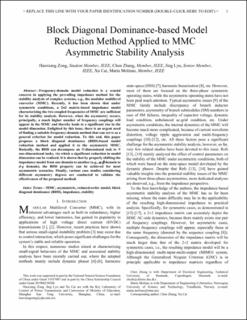| dc.contributor.author | Zong, Haoxiang | |
| dc.contributor.author | Zhang, Chen | |
| dc.contributor.author | Lyu, Jing | |
| dc.contributor.author | Cai, Xu | |
| dc.contributor.author | Molinas Cabrera, Maria Marta | |
| dc.date.accessioned | 2022-10-26T07:45:29Z | |
| dc.date.available | 2022-10-26T07:45:29Z | |
| dc.date.created | 2022-01-10T13:11:30Z | |
| dc.date.issued | 2021 | |
| dc.identifier.citation | IEEE transactions on energy conversion. 2021, 36 (3), 2438-2451. | en_US |
| dc.identifier.issn | 0885-8969 | |
| dc.identifier.uri | https://hdl.handle.net/11250/3028315 | |
| dc.description.abstract | Frequency-domain model reduction is a crucial concern in applying the prevailing impedance method for the stability analysis of complex systems, e.g., the modular multilevel converter (MMC). Recently, it has been shown that under symmetric conditions, a 2 × 2 matrix-based impedance model characterizing the two coupled frequencies of MMC are sufficient for its stability analysis. However, when the asymmetry occurs, principally, a much higher number of frequency couplings will appear in the MMC and thereby leads to a significant rise in the model dimension. Enlighted by this issue, there is an urgent need of finding a suitable frequency-domain method that can serve as a general criterion for model reduction. To this end, this article proposes a block diagonal dominance (BDD)-based model reduction method and applied it to the asymmetric MMC. Basically, the BDD can decompose an N-dimensional task to N one-dimensional tasks, via which a significant reduction in model dimension can be realized. It is shown that by properly shifting the impedance model from one domain to another (e.g., α-β domain to d-q domain), the BDD property can be achieved for most asymmetric scenarios. Finally, various case studies considering different asymmetry degrees are conducted to validate the effectiveness of the proposed method. | en_US |
| dc.language.iso | eng | en_US |
| dc.publisher | Institute of Electrical and Electronics Engineers (IEEE) | en_US |
| dc.title | Block Diagonal Dominance-Based Model Reduction Method Applied to MMC Asymmetric Stability Analysis | en_US |
| dc.type | Peer reviewed | en_US |
| dc.type | Journal article | en_US |
| dc.description.version | acceptedVersion | en_US |
| dc.rights.holder | © IEEE. Personal use of this material is permitted. Permission from IEEE must be obtained for all other uses, in any current or future media, including reprinting/republishing this material for advertising or promotional purposes, creating new collective works, for resale or redistribution to servers or lists, or reuse of any copyrighted component of this work in other works. | en_US |
| dc.source.pagenumber | 2438-2451 | en_US |
| dc.source.volume | 36 | en_US |
| dc.source.journal | IEEE transactions on energy conversion | en_US |
| dc.source.issue | 3 | en_US |
| dc.identifier.doi | 10.1109/TEC.2021.3054925 | |
| dc.identifier.cristin | 1977523 | |
| cristin.ispublished | true | |
| cristin.fulltext | preprint | |
| cristin.qualitycode | 2 | |
